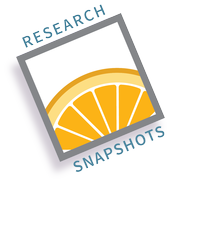A bench to field pipeline for controlling citrus greening disease: A USDA NIFA Project

Research by USDA Agricultural Research Service
Article written by: Michelle Heck, Robert Shatters, Jr. and Randall Niedz
Edited by: Mark Trimmer, Cody Estes, Robert Adair, Peggy G. Lemaux, Lukasz Stelinski, and Ed Stover
From science to solutions – project overview
Citrus greening is a complex, often fatal disease affecting citrus production. This disease is caused by a bacterium (CLas), which is carried by the Asian citrus psyllid. Bacteria-killing therapies, boosting plant immunity and/or preventing CLas transmission by psyllids all have potential to prevent CLas infection. This project aims to develop viable commercial solutions to citrus greening disease with a strong focus on developing delivery methods. Our pipeline contains molecules that we discover and also those that we solicit from the broader community. Our scientists can evaluate molecules by injecting them directly into the tree to see if the molecules have an effect and move systemically. We also test them by using ‘Symbionts’, a new technology for delivery we developed, which is described below.
What are Symbionts and how do they work?
Symbionts are a patented, revolutionary new plant biotechnology tool, similar to an insulin pump in that they deliver molecules directly into the tree. Symbionts are biological, connected to and developing with the tree during the growing season. Symbionts, which can be used in both established groves and new plantings, produce and deliver therapeutic molecules directly into citrus trees to improve tree health. Trees are not genetically altered in any way by Symbionts. Preliminary experiments with Symbionts show promise in the greenhouse and field trials will soon be underway. An innocuous strain of Agrobacterium, a natural soil dwelling bacterium, is the organism that we use to create Symbionts.
Why bypass lab assays and inject molecules directly into the tree?
The citrus industry in Florida is in a steep decline, and growers need an immediate solution. Scientists have made tremendous
progress
developing assays to identify compounds that kill CLas in the lab, but there is little evidence whether these molecules will enhance tree health in the field. Our team has made a comprehensive list of molecules, obtained large quantities of these molecules and are injecting trees to screen for their ability to greatly reduce citrus greening disease in commercial groves. This aspect of the project synergizes with the Symbiont work and we hope will provide growers with a more near-term solution with rapid EPA review and approval.

Who is currently working on this project?
Michelle Heck (Co-Project Director), Stacy DeBlasio, Luke Thompson, David Igwe and Samuel Coradetti (USDA ARS, Ithaca, NY); Robert Shatters (Project Director), Randall Niedz, Wayne Hunter, Joe Krystel Nick Larson, Douglas Stuehler and Cindy McKenzie (USDA ARS and ORISE, Fort Pierce, FL); Robert Adair (Florida Research Center for Agricultural Sustainability, Vero Beach, FL); John Fitzgerald, Laura Fleites, Doug Harper, Marco Pitino, Samantha Sullivan, Mark Trimmer and Patrick Zagorski (AgroSource, Inc.); Lorenzo Rossi, Ellen Cochraine and Guilherme Locatelli (UF-IFAS, Fort Pierce, FL); Jim Thomson (USDA ARS, Albany, CA), Ali Nookmazar, Dan Gibson and Krishna Kannan (Telesis Bio); Monique Rivera (Cornell); Cody Estes (Estes Citrus Inc, Vero Beach, FL); Rodney Cooper (USDA ARS, Wapato, WA)
What are our greatest challenges?
Developing the bench to field pipeline for evaluation of therapies took substantial effort to select delivery methods. Standard injection works well on field trees but is too damaging to use on small greenhouse trees, which must be used for efficient testing of numerous therapeutic compounds. For initial tests, we developed a 3-D printed device which delivers molecules to potted citrus trees. Our team overcame major challenges in the greenhouse evaluation of Symbiont technology. We have shown that Symbionts: do not impair plant health or productivity; can be produced rapidly on citrus (in one month); and can mitigate citrus greening in potted trees when used to deliver high impact therapeutic molecules. The greatest and most important challenge is conducting whole-tree evaluations in the field where there are many challenging variables. We are very fortunate to have grower cooperation and the assistance of the USDA APHIS and the EPA for field trials.
